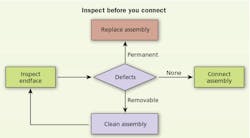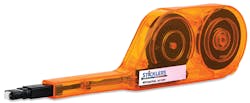Ensure your multifiber cabling network runs smoothly
Keeping MPO-based systems free from contamination is critical to its proper operation.
By Mike Jones, MicroCare Corp.
Demand for new technology brings with it the requirement for greater bandwidth, and the need for increased connectivity, putting pressure on the network architecture. To meet this growth, data centers and fiber network providers are choosing connectivity that gives them greater options and increases data-capacity options. Many are opting to use MPO (multifiber push-on) connectors to help in this quest. MPO connectors have surged in popularity as they allow more fiber to be easily installed into existing equipment. However, they are extremely vulnerable to contamination. With the deployment of 40G and 100G systems, it is essential that connections are reliable and efficient. Critical to a seamless network is the implementation of a successful fiber cleaning process.
Always inspect a fiber endface, clean it if necessary, then reinspect to ensure its cleanliness before connecting.
The importance of cleaning
Fiber connectors are crucial joining points in any network, so if not cleaned correctly it will result in connection failure. It is key to remember that contamination is the number-one threat to any fiber-optic network. If particulate is in the contact zone of a mated connector pair it will interrupt the optical signal, causing insertion loss and reflectance and can even damage connectors.
The importance of cleanliness becomes even more apparent with the use of MPO connectors. With a larger surface area than a single fiber connector, and the capacity to contain up to 72 fibers across a single connector ferrule, the risk of contaminants finding their way to the fiber increases. Height variation can also be problematic. On a high-performance MPO or MT (mechanical transfer) ferrule, the fiber’s geometry can differ, with protrusion varying 1 to 3 µm. This increases the risk of the fiber not being cleaned equally. Finding a dependable cleaning method to ensure faultless fiber cleanliness is essential.
What contamination?
Let’s explore what contamination can affect an MPO connector. There are many sources of contamination, however dust particles are a particular enemy. Airborne dust can come from dead skin, plant pollen, vehicle emissions, cardboard boxes and even clothing lint. Outgassed plasticizers from protective dust caps, can also produce debris. The very items used in a cleaning kit can be problematic. Dust particulate can be produced from foam cleaning swabs, paper-based swabs, and cross-contaminated cleaning fluids.
The primary cause of dust-based contamination, however, is connector “wear debris.” Wear debris dust is caused by the contact friction when connectors are mated. Examples: from the connector slider, the retention clips in adapters and transceivers, and also from the guide pins. The same strong contact force that holds pair mated termini together, will also grind dust particles into the ferrule surface, resulting in scratched, pitted or scarred endfaces. This can cause backreflection, signal attenuation, instability in the laser system and even a complete system shutdown.
Be aware of the differences
MPO connectors are extremely vulnerable to contamination. Because they are difficult to clean, technicians often skip the cleaning step and hope the endface will be clean enough.
It is not the design of the connector that is the problem; it is the quantity of connectors that makes the difference. In a big data center, there may be thousands of MPO connectors that need to be cleaned as networks are moved and reconfigured. This means technicians need tools that give them fast and reliable cleaning in seconds.
Although it is important to be aware of the increased number of fibers within an MPO connector, it is also worth noting that fewer connectors are required for the same job. This makes installation and maintenance simpler for technicians. It is easier and quicker to clean an MPO with the correct tools than concentrating on many separate single-fiber connectors.
Click-to-clean tools are an effective way to clean MPO connectors.
A unique feature of an MPO is the indicator on the side of the connector helping technicians to line up cables and connectors to ensure polarity. The industry standard, IEC 61754-7, requires the connectors to have an alignment key on the MPO connector and adapter for maintaining the signal. Earlier versions of MPO cleaning tools used the same design for cleaning angled polished singlemode MPO connectors. But in today’s densely configured data centers, central offices and headends, there is a desire by network designers to combine more MPO connections into the 1RU footprint. The alignment key impedes this goal. Thanks to advancements in cleaning tools, the alignment key for controlling the flow of the cleaning ribbon on angle polished MT ferrules is not required. Modern cleaning tools can easily be inserted in either direction. This enables the operator to insert the cleaner into the adapter in any position that keeps the cleaning ribbon spools clear or floors, ceilings, doors and cable routing features on the panel.
How to successfully clean an MPO
Without tried and tested modern cleaning methods in place, the increasing pressures put on network providers and technicians will only escalate as they try to keep systems running efficiently.
The most practical thing a technician can do is to always inspect, clean and reinspect all the termini on both ends of a connector pair. The inspection processes help to visually identify problems like permanent defects, for example scratches and pitting, and any contamination that can interfere or damage the surface of the optical termini.
Shown here is the side view of a cleaning tip of a push-to-clean tool on an MPO connector.
Because no cleaning process is ever fully guaranteed, it is important to visually inspect the termini for contamination; this helps to identify the possible sources of the contamination. Steps can then be taken to try to eliminate the root problem. Inspection is also beneficial as the technician will know when the terminus surface is free of contamination and ready for the connector pair to be mated.
The most effective method to eliminate all contamination is through wet-dry cleaning. Use a specifically developed fiber cleaning fluid that is fast-drying, non-flammable, has a low surface tension and dissipates static.
If you are using IPA alcohol, stop! Not only is it highly flammable, but it also has a slower evaporation rate when compared to the modern chemistries that have been engineered specifically for cleaning fiber-optic connectors. IPA is highly hygroscopic and will attract water molecules from the air, contaminating the cleaning fluid and degrading its ability to clean.
Always use a specialized cleaning fluid that is quick to dry so moisture does not have time to draw into the fluid—a major source of contamination. Another tip: Make sure the cleaning fluid comes in hermetically sealed containers as it prevents cross-contamination and spills.
One of the best tools for the job is a “click-to-clean” cleaning tool that is extremely convenient and quick to use. It will effectively clean an MPO even with its uneven geometry. The beauty of this cleaning method is its ability to clean connectors, whether male or female, in any size and for any scale fiber-optic network, while delivering the lowest cost per cleaning. These MPO cleaning tools are becoming more widely available, but it is important to ensure the device is from an established vendor that offers quality cleaning tools because a cheap, poorly made tool will damage endfaces.
Start by selecting an optical-grade lint-free wipe specifically engineered for cleaning fiber. Next, add the cleaning fluid to the wipe. Dampen the tool by passing it over the wipe. Do not saturate the tool as this will only move the contamination around. Insert the solvent-dampened device into the connector and simply push down to clean. It is essential that both ends of the connector pair are cleaned, otherwise you will cross-contaminate.
To accomplish the dry portion of the cleaning process, an additional activation of the device assures that any excess solvent has been removed. Finally, reinspect to ensure the connector is clean. Upon inspection, if the connector is not clean after the first cleaning, the process can be repeated.
Although not a new technology, MPO connectors are a faster way to manage the increasing complexity required for network connectivity. To guarantee their stability and reliability, it is important to find a fiber cleaning method that is affordable, quick, consistent and effective. By introducing modern cleaning procedures, it will not only save time and money, but also make a network substantially more reliable, helping to withstand the pressure on the network’s increasing connectivity demands.
Mike Jones is vice president of MicroCare Corp., which offers Sticklers brand (www.sticklerscleaners.com) fiber cleaning solutions.



